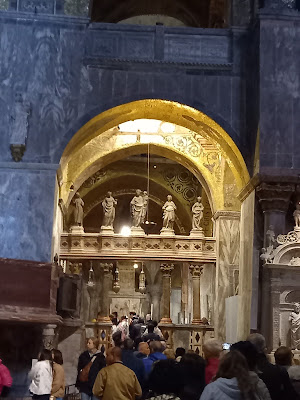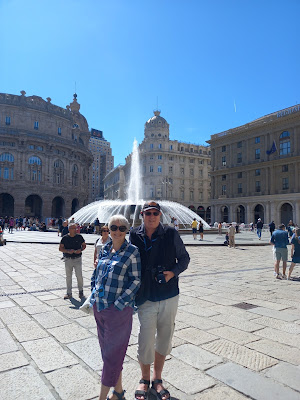Today’s entertainment was a walking tour of Florence. We
met our guides, Marianna and Uli, at 10:00 and split into two groups, to take
in the sights of the city. We first stopped at the Palazzo Strozzi, which turned
out to be one of the first banks of Florence. In the Renaissance, Florence
invented banking, amongst other things, which led it to become pre-eminent among
the city-states of Northern Italy.
On our way to the next place we stopped at a wine window,
literally a hole in the wall through which wine was sold.
Our next stop was Santa Maria Novella, a church which
epitomises the ethos of the Renaissance with its perfect proportions. Uli said
he wasn’t going to give us a load of facts and figures about this…but then he
did anyway, emphasising the proportions of the doors, windows and columns.
From there we proceeded to the Duomo & Giotto Bell
Tower, which was once the largest dome in the world. Outside is the baptistry,
an octagonal building which represents the first six days of the Creation, the
seventh day of rest, and the eighth day, the resurrection. If you ain’t
baptised, you won’t be there. It also contains an early Renaissance concept –
self-portraits in bronze of the artists who created the doors, as an early form
of advertising.
 |
| The Octagon |
We then headed to
Piazza Repubblica, which has been
rebuilt almost entirely in the late 19
th century, destroying and replacing
the old market and some residential palazzos, the old Jewish Ghetto, and
various other historical buildings. The threat of a cholera epidemic gave
impetus to the slum clearances. It was a symbol of the new Italy, recently
united into a single country. Everyone hated it.
 |
| 3D map of the city, with braille |
Our final stop of the morning was Piazza della Signoria,
which is outside the Uffizi Museum. There’s a replica David outside the museum,
as well as a fountain with Neptune, and a statue of Cosimo De' Medici on a horse,
as well as various other statuary. The place was pretty well swarming with
tourists by this point. Here, we were left to our own devices to find lunch, to
reassemble at 1:30pm for the tour of the Uffizi.
We found a little café suitable for lunch, then headed up
towards the Basilica de Santa Croce, with the idea of having a look inside…but
the queue to get tickets would have eaten up all our remaining time, so we
admired the outside and met the rest of our group at the appointed hour.
The tour of the Uffizi took the form of a history of the
development of Western art. Uli started us off in a medieval room, pointing out
the medieval style of painting, its purpose and philosophy behind it. We then gradually worked towards the Renaissance, stopping to observe key developments in art along the
way – such concepts as background, movement, perspective, nude, non-religious
subject matter, and perspective of air. It was all very interesting, but I
developed a bad case of museum back, and we decided in the end to skip the
visit to see David – housed in the Accademia Gallery, a little further out to
the north of the city, as a sculpture too far.
 |
| Medieval art |
 |
| David outside the Uffizi |
In the evening we went out for dinner at Ristorante i Tre Pini, housed in an old Tuscan farmhouse, where we enjoyed a typical Italian meal...again. However, the antipasto and crostini were high quality, and this time the meat was roast pork. During dinner we'd been entertained by a guitarist and two singers - a soprano and a bass - and after dinner we sang along and joined in. Our guide Bonnie, after a few glasses of wine, was in fine form, much to the surprise of the professional singers. He is, after all, a classically trained tenor, but they didn't know this at the time.


















































